Learning to scuba dive abroad is not only more fun, but often cheaper too!
Are you ready to dive into the underwater world and explore the beauty of marine life? Learning to scuba dive is an exciting and fulfilling experience that opens up a whole new world of adventure. But with so many diving destinations to choose from, it can be overwhelming to decide where to start.
That’s why we’ve compiled a list of the 10 top-rated places to learn to scuba dive, both for experienced divers and new divers with an itch to learn how to scuba dive. From the Caribbean to the Maldives, and everywhere in between, these breathtaking locations offer the best dive schools in the world, with awesome instructors and reliable dive gear.
So, grab your fins, get ready to discover the beauty of the underwater world and become a certified diver in one of these amazing places.
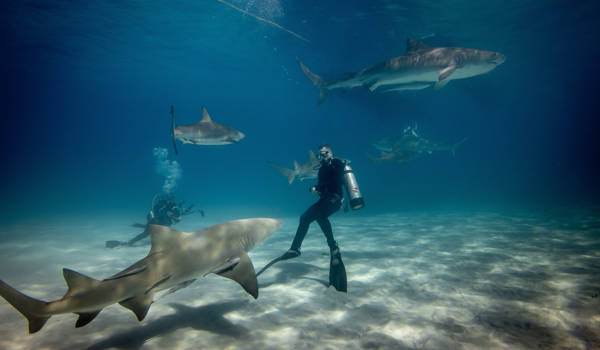
Why would you learn to dive abroad?
There are many benefits of learning to dive abroad vs. in your home country. You can experience different diving environments, learn from different instructors, and meet new people from different cultures.
You can also gain a unique perspective on the world and learn about different cultures and ways of life. You may also have the opportunity to learn about marine conservation efforts and how to protect the ocean’s ecosystems.
1. Cairns in Australia
Cairns in the northeast of Australia is a top-rated destination for scuba diving enthusiasts. The Great Barrier Reef - the world’s largest coral reef system - is located just off the coast of Cairns and offers an incredible opportunity to explore the underwater world.
The water temperature in Cairns varies throughout the year, ranging from a comfortable 29 degrees Celsius in summer (December - February) to 22 degrees Celsius during the Australian winter (which is between June - August).
The warm waters of Cairns are home to a diverse range of marine life, including sea turtles, reef sharks, and colorful fish. Cairns is also home to some of the best dive schools in the world, where we offer PADI certified open water courses, advanced courses, and liveaboard fundiving experiences.
Whether you’re a beginner or an experienced diver, Cairns is the perfect place to learn and explore the beauty of the great reef diving opportunities in Australia.
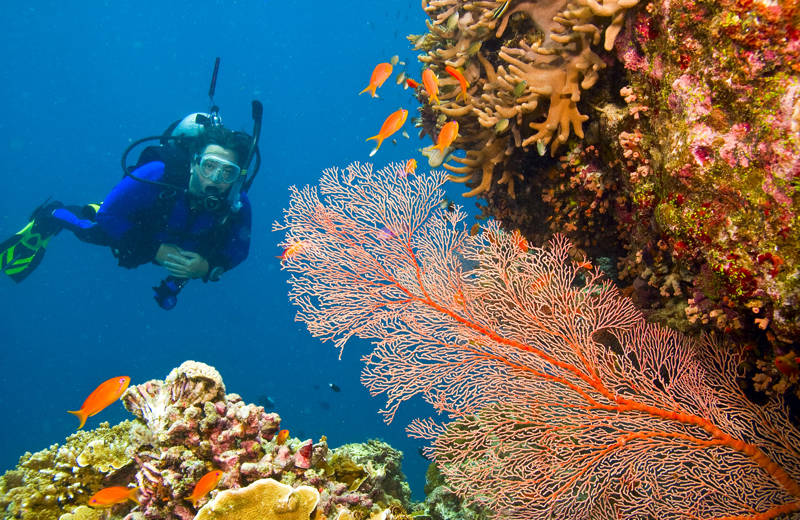
2. Koh Tao in Thailand
Koh Tao in Thailand should be on the bucket list of all (wannabe) scuba divers. The water temperature around Koh Tao is usually between 27 and 30 degrees Celsius on average, making it an ideal location for diving throughout the year.
The island is surrounded by a coral reef ecosystem that provides a home to a diverse range of great marine life. You can expect to see a variety of colourful fish, including angelfish, butterflyfish, bannerfish, and stingrays, as well as hard corals such as table coral, staghorn coral, mosaic, and mushroom corals. If you’re lucky, you might even spot whale sharks or eagle rays.
Koh Tao is also home to some of the best dive schools in the world, such as the ones on Sairee beach and Chalok Bay, which offer PADI certified open water courses, advanced courses, and fundiving for experienced divers.
When you’re not diving, you can relax on the island’s white sandy beaches, explore the steep and rocky terrain covered in thick jungle, or wander around and have some amazing Thai food. Learn to dive in Koh Tao and explore a bit of Thai culture while you're at it!
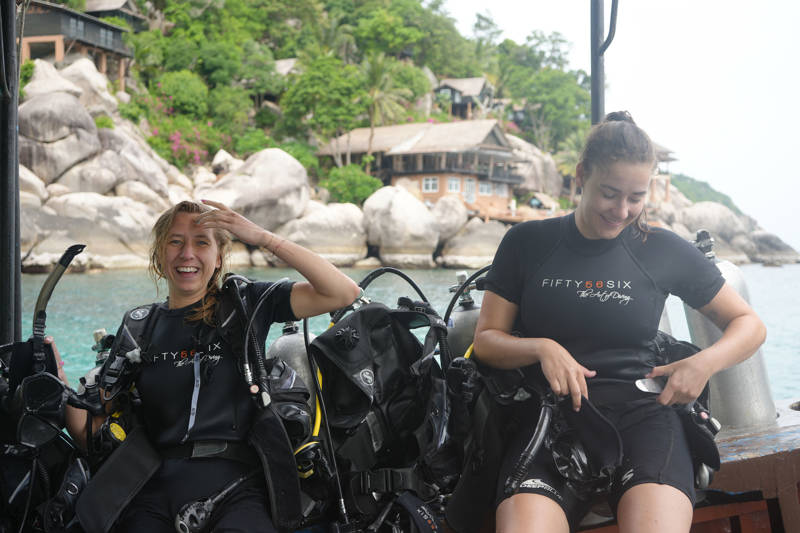
3. Dauin in the Philippines
The Philippines is a country known for its amazing scuba diving, and Dauin is the primary place to get your wetsuit on. The water temperature around Dauin is usually between 27 and 30 degrees Celsius on average, making it an ideal location for diving throughout the year.
The island is surrounded by a coral reef ecosystem that provides a home to a diverse range of marine life. The waters surrounding Dauin are filled with colourful fish, including clownfish, angelfish, butterflyfish, and lionfish, as well as hard corals such as table coral, staghorn coral, mosaic, and mushroom corals. If you’re lucky, you might even spot a sea turtle or a whale shark.
In Dauin we offer regular dive courses for both beginners and advanced divers. And we've also got something truly special here with our marine conservation program - you'll learn how to dive while helping the underwater environment.
If you're already an experienced diver, you can go for your divemaster certificate in this amazing environment. Being the island paradise it is, the Philippines will make you never want to go home!
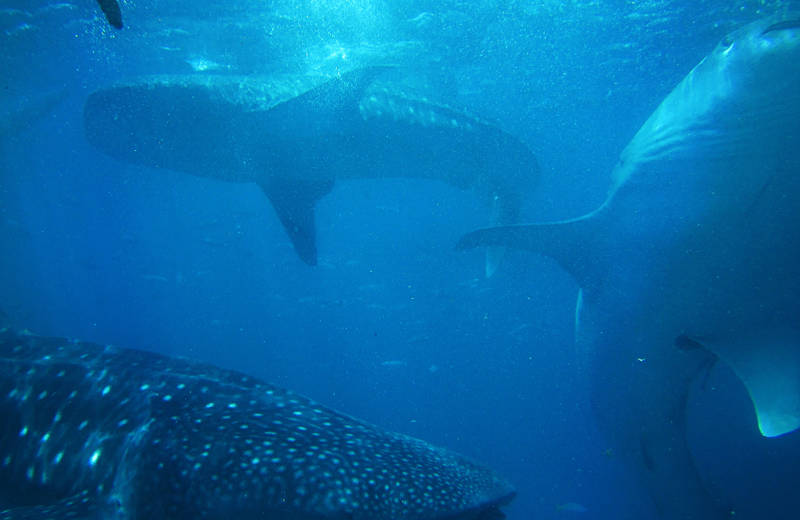
4. The Gili islands in Indonesia
Indonesia is full of great dive sites, both for shore dives and boat dives. But the Gili Islands take the cake. The water temperature around these popular islands is usually between 28 and 30 degrees Celsius on average, making the tropical waters an ideal location for diving throughout the year.
The islands are surrounded by a coral reef ecosystem that provides a home to a diverse range of marine life. You can expect to see a variety of colourful fish, including clownfish, angelfish, butterflyfish, and lionfish, as well as hard corals such as table coral, staghorn coral, mosaic, and mushroom corals. If you’re lucky, you might even spot a sea turtle or a whitetip reef shark!
Indonesia is always a great adventure, and diving on the Gili islands makes it even more exciting.
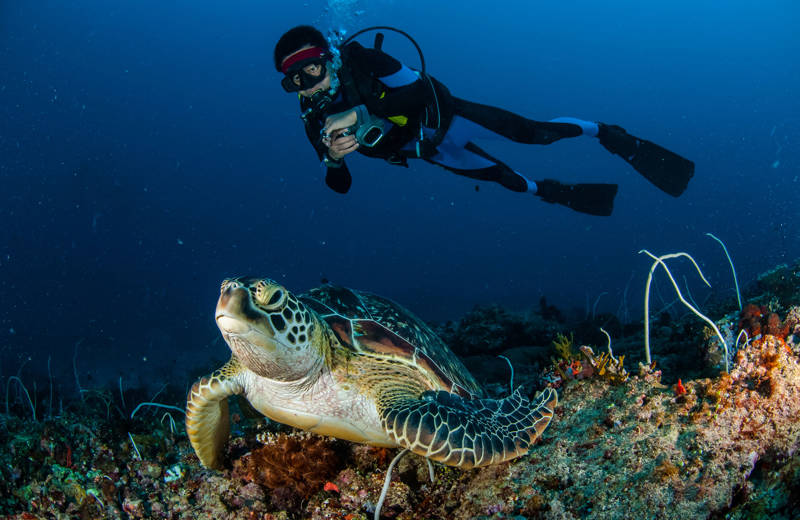
5. Quepos in Costa Rica
Costa Rica is one of the most biodiverse countries on the planet, and that certainly also goes for its marine ecosystems. Our recommended diving action happens in Quepos, on the southern Pacific coast of the country, not far from Manual Antonio National Park.
The water temperature around Quepos is usually between 26 and 30 degrees Celsius on average, making it an ideal location for scuba diving throughout the year. The volcanic rock reef around Manuel Antonio National Park is home to a diverse range of marine life, including puffer fish, scorpion fish, parrot fish, angel fish, moorish idols, octopus, trumpets, eels, sea turtles, nudibranchs, and a variety of crustaceans.
Among the hard and soft corals live massive schools of jacks and snappers. In terms of larger underwater life, there are white-tip reef sharks, stingrays, and spotted eagle rays. From December to May, keep your eyes peeled and make sure to look above you for the gentle giant manta rays. During these same months, you might see humpback whales or large pods of dolphins along the coast as well.
When you're done with diving for the day, we recommend exploring the amazing beaches and forests surrounding Quepos. Costa Rica really is a piece of paradise and one of our favourite dive destinations in Central America!
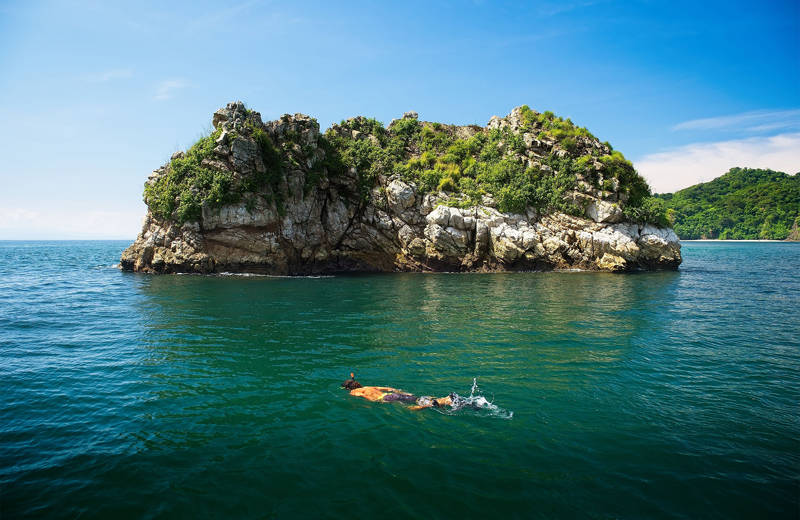
6. Nadi in Fiji
Another dream destination for those wanting to learn to scuba dive is Nadi in Fiji. Nadi is a gateway to some of the most amazing dive sites in the Pacific, where you can explore coral reefs, swim-throughs, caverns, canyons and even encounter the occasional shark.
The best time to go is from May to October, when the water is clear and calm, and the visibility can reach up to 40 metres. The water temperature is a pleasant 27°C (82°F) throughout the year.
While diving in Fiji, you might see a variety of animals, such as turtles, dolphins, wahoo, manta rays and whale sharks. And when you're done with diving for the day, there are a lot of other water activities to enjoy, such as sailing, fishing, snorkeling and kayaking.
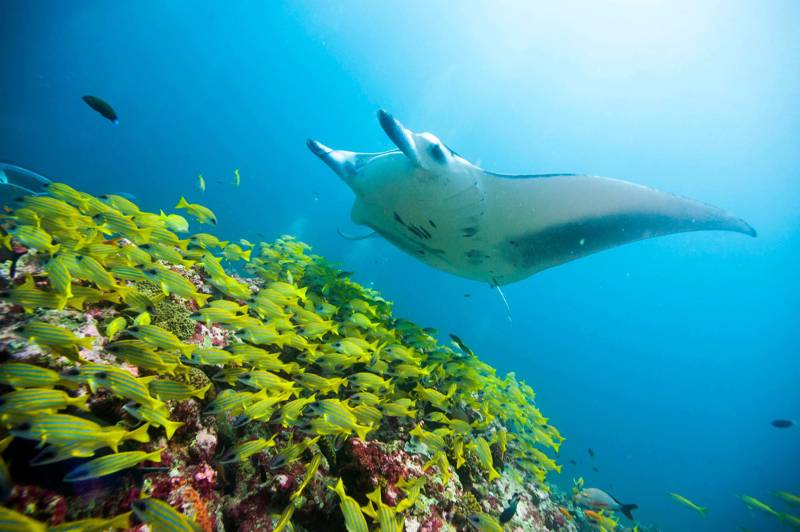
7. Zanzibar in Tanzania
It's not just Asia and Oceania that are great places for learning to dive. How about Zanzibar, a beautiful island off the coast of Tanzania in Africa?
Zanzibar has some of the most impressive dive sites in the world, with over 400 species of fish, colourful coral reefs, and even some wrecks to explore. The best time to go diving in Zanzibar is from June to October, when the water is clear and calm, and the visibility can reach up to 30 meters. The water temperature is also very comfortable, ranging from 25°C to 28°C.
One of the most popular dive spots in Zanzibar is Mnemba Atoll, a 7km-long reef that is home to turtles, dolphins, and even whale sharks if you choose the right season. You can also dive at Tumbatu Island, where you can see giant moray eels, lionfish, and octopus. Or you can try Levan Bank, where you can encounter bigger fish like the kingfish, trevally, and tuna.
No matter what level of diver you are, you will find something to suit your taste and skill.
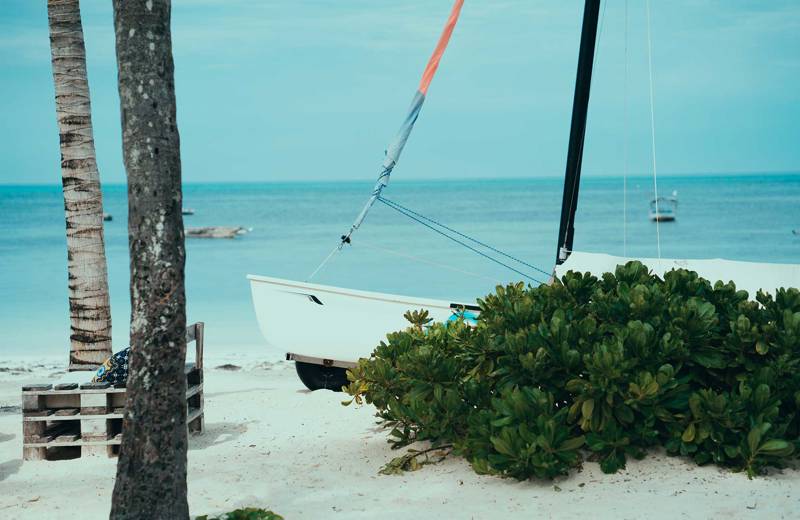
8. The Perhentian Islands in Malaysia
If you're looking for a diving location a little less ordinary, the Perhentian Islands in Malaysia are right up your alley. They are part of the Terengganu Marine Park and have some amazing dive sites for all levels of divers. You can see turtles, sharks, rays, barracudas, coral gardens and more!
The best time to go diving on the Perhentian Islands is from late March to early October, when the weather is dry and sunny. The water temperature is around 28°C to 30°C, which is perfect for diving. The visibility can range from 10 to 20 metres, depending on the conditions.
Some of the best dive sites on the Perhentian Islands are:
-
Tokong Laut: A pinnacle that rises from 25 to five metres below the surface. It is covered with soft corals and sponges and attracts lots of fish, such as jacks, trevallies, snappers and fusiliers. You might also spot some blacktip reef sharks and giant groupers here.
-
Sugar Wreck: A sunken cargo ship that lies at 18 metres depth. It is home to a variety of fishes and animals, such as lionfish, scorpionfish, moray eels, batfish and nudibranchs. You can explore the wreck and see the cargo of sugar bags still intact.
-
T3: A reef slope that descends from 12 to 22 metres. It has a lot of hard corals and sea fans, and is frequented by turtles, stingrays, parrotfish and triggerfish. You can also find some smaller critters here, such as shrimps, crabs and pipefish.

9. Thulusdhoo in the Maldives
If it's tropical paradise you're after, you should really check out Thulusdhoo in the Maldives. Thulusdhoo is a small island in the North Male Atoll, where you can find some of the best diving sites in the country.
While you might associate the Maldives with expensive dive resorts, there are options for diving on a smaller budget too! If you're lucky, you'll scuba dive among sharks, manta rays, turtles, and colourful fish, and explore stunning coral reefs and wrecks.
The best time to go diving in Thulusdhoo is from December to May, when the water is calm, and the visibility is excellent. The water temperature is around 28°C all year round, so you won't be shivering at all!
Thulusdhoo is also a great place to relax and enjoy the island life, taste the local food, and watch the amazing sunset from the beach. It really is a paradise for divers and non-divers alike, and you will never forget your diving adventure there.
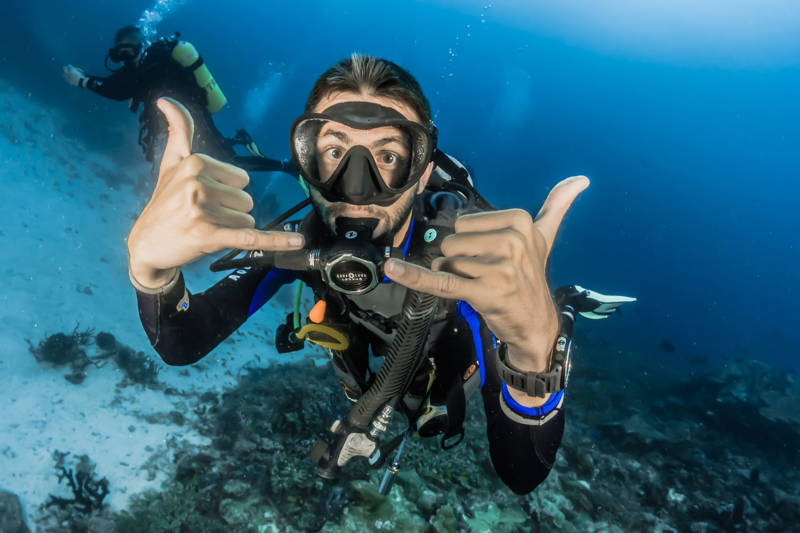
10. Nusa Lembongan in Indonesia
Indonesia, again! With over 6,000 populated islands, it's no surprise there are some great diving spots scattered around Indonesia.
Nusa Lembongan might seem like a tiny island, but it has a lot to offer and is easy to reach from Bali. The island is a real treasure box, both for excellent shore diving sites and boat diving. Around Nusa Lembongan you can see amazing marine life, like manta rays, mola mola, sharks, turtles, and colourful corals.
The best time to go diving on Nusa Lembongan is from July to October, when the water is clear and the chances of seeing mola mola are high. The water temperature ranges from 20°C to 28°C, depending on the season and the dive site.
We work with the best dive schools on Nusa Lembongan, and offer daily diving trips, PADI courses, and accommodation for divers of all levels. Whether you want to explore the stunning reefs, swim with the majestic mantas, or challenge yourself with some drift dives, Nusa Lembongan has something for everyone.


